Interconnecting Microgrids via the Energy Router with Smart Energy Management
Abstract
:1. Introduction
2. Energy Router-Based Interconnecting Framework for Microgrids
- (1)
- as for the case in Figure 3a, both microgrid 1 and microgrid 2 are taking energy from the main grid, as the direction of power flow is from power grid to the microgrids. In this situation, both microgrid 1 and microgrid 2 are operating in the grid-connected mode;
- (2)
- as for the case in Figure 3b, microgrid 1 can be self-sufficient while microgrid 2 is taking energy from the main grid, as the direction of power flow is only from the power grid to microgrid 2. In this situation, microgrid 1 is operating in the islanded mode while microgrid 2 is operating in the grid-connected mode;
- (3)
- as for the case in Figure 3c, microgrid 1 is taking energy from both the main grid and microgrid 2, while microgrid 2 can not only operate on its own energy production, but provides surplus power to microgrid 1 as well. The direction of power flow is from both the main grid and microgrid 2 to microgrid 1. In this situation, microgrid 1 is operating in the grid-connected mode, while microgrid 2 is operating in the parallel mode;
- (4)
- as for the case in Figure 3d, microgrid 1 is providing surplus power to microgrid 2, while no power needs to be transferred from the main grid to the DC power line. The direction of power flow is from microgrid 1 to microgrid 2. In this situation, both microgrid 1 and microgrid 2 are operating in the parallel mode.
3. Topology and Mathematical Model of the Energy Router
3.1. Topology of the Energy Router
3.2. Analytical Model of the Energy Router
4. Energy Control Strategies of the Energy Router
4.1. Control Schematic of the VSCs
4.2. Control Patterns for the VSCs
- (1)
- once the main grid is involved in power transfer, VSC0 is chosen to be the master converter, working in pattern 1;
- (2)
- for a microgrid working in the grid-connected mode, the VSC beside the power grid must be working in pattern 3;
- (3)
- for a microgrid working in the parallel mode, the corresponding control pattern of its VSC is determined according to the other microgrid’s operational mode. For example, when microgrid 2 works in parallel mode and microgrid 1 is in the grid-connected mode, which corresponds to the case represented in Figure 3c, VSC2 must be working in pattern 2, because the surplus energy of microgrid 2 is transferred to the DC power line through it;
- (4)
- when both microgrid 1 and microgrid 2 are in parallel mode, as in Figure 3d, VSC2 is working in pattern 3 and VSC1 is working in pattern 1, because the direction of energy flow is from microgrid 2 to microgrid 1.
4.3. Control Patterns for the Energy Router
5. Dual-Loop Feedback Control
5.1. Inner Loop Controller
5.2. Outer-Loop Controller
5.2.1. Active/Reactive Power Controller
5.2.2. DC Voltage Controller
6. Simulation Studies
6.1. Scenario 1
6.2. Scenario 2
6.3. Scenario 3
6.4. Scenario 4
7. Conclusions
- (1)
- apart from the grid-connected mode and the islanded mode, microgrids interconnected with the energy router can operate in the parallel mode when flexible energy flow among adjacent microgrids is enabled by the energy router. Therefore, energy surpluses or deficits can be compensated by complementary energy exchanges on the microgrid side without interference of the main power grid;
- (2)
- facilitated by the energy router with the presented control strategies, the microgrids can switch freely and flexibly among the multiple operational modes, according to their energy demands and operational statuses;
- (3)
- The VSC converters and shared DC bus of the energy router facilitate electrical isolation between the microgrids and the main grid, which ensures that any voltage or frequency fluctuation at one end of the energy router will have no direct impact on the systems on other sides of the energy router, thus guaranteeing power quality and operational reliability.
Acknowledgments
Author Contributions
Conflicts of Interest
References
- Huang, A.Q.; Crow, M.L.; Heydt, G.T. The Future Renewable Electric Energy Delivery and Management (FREEDM) System: The energy internet. Proc. IEEE 2011, 99, 133–148. [Google Scholar] [CrossRef]
- Lasseter, R.H. Smart Distribution: Coupled Microgrids. Proc. IEEE 2011, 99, 1074–1082. [Google Scholar] [CrossRef]
- Walling, R.A.; Saint, R.; Dugan, R.C. Summary of Distributed Resources Impact on Power Delivery Systems. IEEE Trans. Power Deliv. 2008, 23, 1636–1644. [Google Scholar] [CrossRef]
- Barnes, M.; Kondoh, J.; Asano, H. Real-World MicroGrids-An Overview. In Proceedings of the 2007 IEEE International Conference on System of Systems Engineering, San Antonio, TX, USA, 16–18 April 2007; pp. 1–8. [Google Scholar]
- Olivares, D.E.; Mehrizi-Sani, A.; Etemadi, A.H. Trends in Microgrid Control. IEEE Trans. Smart Grid 2014, 5, 1905–1919. [Google Scholar] [CrossRef]
- Yang, Z.; Zhang, J.; Kintner-Meyer, M.C. Electrochemical Energy Storage for Green Grid. Chem. Rev. 2011, 111, 3577–3613. [Google Scholar] [CrossRef]
- Díaz, N.L.; Luna, A.C.; Vasquez, J.C. Centralized Control Architecture for Coordination of Distributed Renewable Generation and Energy Storage in Islanded AC Microgrids. IEEE Trans. Power Electron. 2017, 32, 5202–5213. [Google Scholar] [CrossRef]
- Bragard, M.; Soltau, N.; Thomas, S. The Balance of Renewable Sources and User Demands in Grids: Power Electronics for Modular Battery Energy Storage Systems. IEEE Trans. Power Electron. 2010, 25, 3049–3056. [Google Scholar] [CrossRef]
- Divya, K.C.; Østergaard, J. Battery Energy Storage Technology for Power Systems—An Overview. Electr. Power Syst. Res. 2009, 79, 511–520. [Google Scholar] [CrossRef]
- Cheng, S.; Sun, W.B.; Liu, W.L. Multi-Objective Configuration Optimization of a Hybrid Energy Storage System. Appl. Sci. 2017, 7, 163–174. [Google Scholar] [CrossRef]
- Levelized Cost of Storage Analysis 2.0. Available online: https://www.lazard.com/perspective/levelized-cost-of-storage-analysis-20/ (accessed on 15 December 2016).
- Lindley, D. The Energy Storage Problem. Nature 2010, 7, 18–20. [Google Scholar] [CrossRef]
- Clement-Nyns, K.; Haesen, E.; Driesen, J. The Impact of Vehicle-to-grid on the Distribution Grid. Power Syst. Res. 2011, 81, 185–192. [Google Scholar] [CrossRef]
- Baumann, C.; Schuster, R.; Moser, A. Economic Potential of Power-to-gas Energy Storages. In Proceedings of the International Conference on the European Energy Market(EEM), Stockholm, Sweden, 27–31 May 2013; pp. 1–6. [Google Scholar]
- Rodrigues, E.M.G.; Godina, R.; Santos, S.F. Energy Storage Systems Supporting Increased Penetration of Renewables in Islanded Systems. Energy 2014, 75, 265–280. [Google Scholar] [CrossRef]
- Díaz-González, F.; Sumper, A.; Gomis-Bellmunt, O. A Review of Energy Storage Technologies for Wind Power Applications. Renew. Sustain. Energy Rev. 2012, 16, 2154–2171. [Google Scholar] [CrossRef]
- Liu, Z.; Chen, C.; Yuan, J. Hybrid Energy Scheduling in a Renewable Micro Grid. Appl. Sci. 2015, 5, 516–531. [Google Scholar] [CrossRef]
- Huang, A.Q.; Baliga, J. FREEDM System: Role of Power Electronics and Power Semiconductors in Developing an Energy Internet. In Proceedings of the International Symposium on Power Semiconductor Devices and ICs, Barcelona, Spain, 14–18 June 2009; pp. 9–12. [Google Scholar]
- Zhang, J.; Wang, W.; Bhattacharya, S. Architecture of Solid State Transformer-based Energy Router and Models of Energy Traffic. In Proceedings of the 2012 Innovative Smart Grid Technologies (ISGT), Washington, DC, USA, 16–20 January 2012; pp. 1–8. [Google Scholar]
- Takahashi, R.; Kitamori, Y.; Hikihara, T. AC Power Local Network with Multiple Power Routers. Energies 2013, 6, 6293–6303. [Google Scholar] [CrossRef] [Green Version]
- Kandula, R.P.; Iyer, A.; Moghe, R. Power Router for Meshed Systems Based on a Fractionally Rated Back-to-Back Converter. IEEE Trans. Power Electron. 2014, 29, 5172–5180. [Google Scholar] [CrossRef]
- Xu, Y.; Zhang, J.; Wang, W. Energy Router: Architectures and Functionalities toward Energy Internet. In Proceedings of the 2011 IEEE International Conference on Smart Grid Communications (SmartGridComm 2011), Brussels, Belgium, 17–20 October 2011; pp. 31–36. [Google Scholar]
- Takuno, T.; Kitamori, Y.; Takahashi, R. AC Power Routing System in Home Based on Demand and Supply Utilizing Distributed Power Sources. Energies 2011, 4, 717–726. [Google Scholar] [CrossRef] [Green Version]
- Saponara, S.; Bacchillone, T. Network Architecture, Security Issues, and Hardware Implementation of a Home Area Network for Smart Grid. J. Comput. Netw. Commun. 2012, 7, 285–293. [Google Scholar] [CrossRef]
- Nguyen, P.H.; Kling, W.L.; Ribeiro, P.F. Smart power router: A flexible Agent-based Converter Interface in Active Distribution Networks. IEEE Trans. Smart Grid 2011, 2, 487–495. [Google Scholar] [CrossRef]
- Yu, X.; She, X.; Zhou, X. Power Management for DC Microgrid Enabled by Solid-state Transformer. IEEE Trans. Smart Grid 2014, 5, 954–965. [Google Scholar] [CrossRef]
- Zhang, Y.; Umuhoza, J.; Liu, Y. Optimized control of isolated residential power router for photovoltaic applications. In Proceedings of the Energy Conversion Congress and Exposition, Pittsburgh, PA, USA, 14–18 September 2014; pp. 53–59. [Google Scholar]
- Cao, J.W.; Meng, K.; Wang, J.Y. An energy internet and energy routers. Sci. Sin. Inf. 2014, 44, 714. [Google Scholar] [CrossRef]
- Saponara, S. Distributed Measuring System for Predictive Diagnosis of Uninterruptible Power Supplies in Safety-Critical Applications. Energies 2016, 9, 327. [Google Scholar] [CrossRef]
- Saponara, S.; Fanucci, L.; Bernardo, F. Predictive Diagnosis of High-Power Transformer Faults by Networking Vibration Measuring Nodes With Integrated Signal Processing. IEEE Trans. Instrum. Meas. 2016, 65, 1749–1760. [Google Scholar] [CrossRef]
- Tonkoski, R.; Turcotte, D.; El-Fouly, T.H.M. Impact of High PV Penetration on Voltage Profiles in Residential Neighborhoods. IEEE Trans. Sustain. Energy 2012, 3, 518–527. [Google Scholar] [CrossRef]
- Majumder, R.; Ghosh, A.; Ledwich, G. Power Management and Power Flow Control with Back-to-Back Converters in a Utility Connected Microgrid. IEEE Trans. Power Syst. 2010, 25, 821–834. [Google Scholar] [CrossRef] [Green Version]
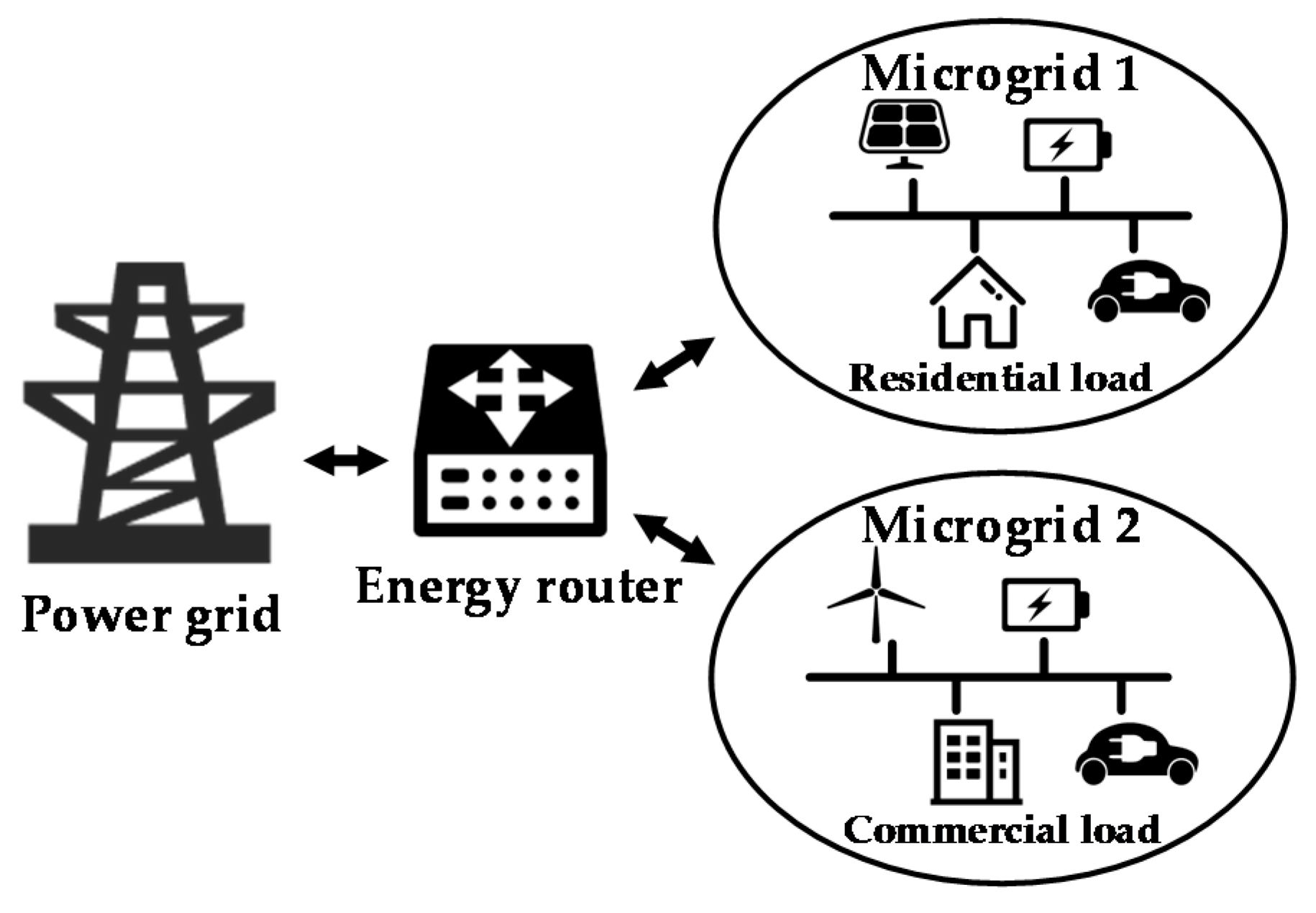
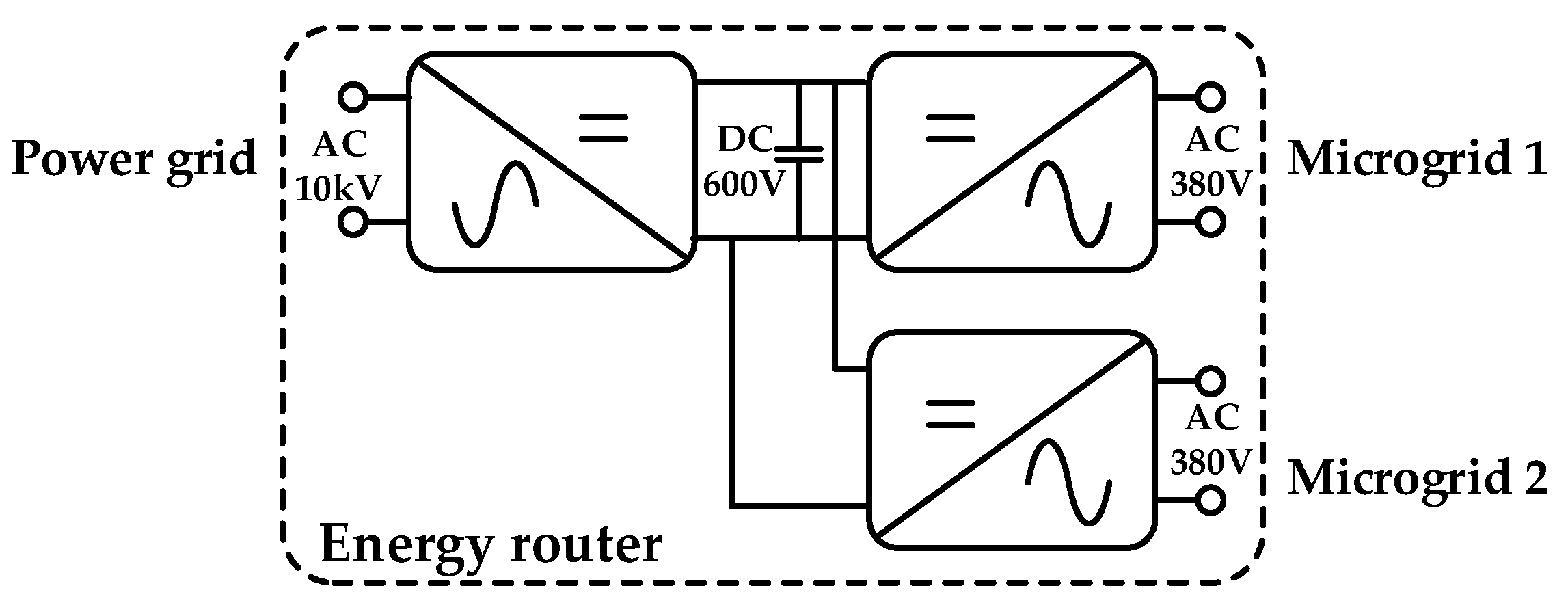

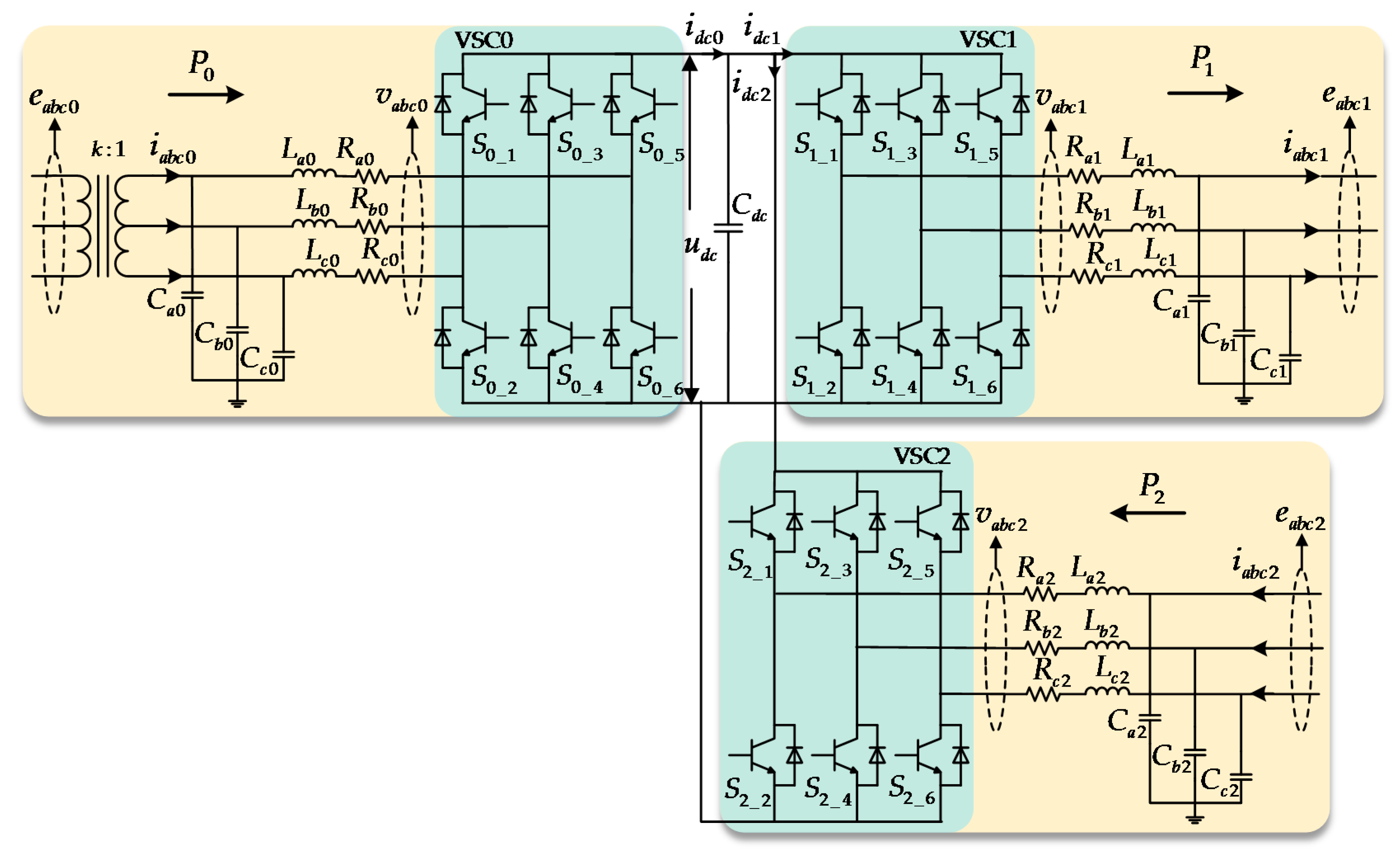
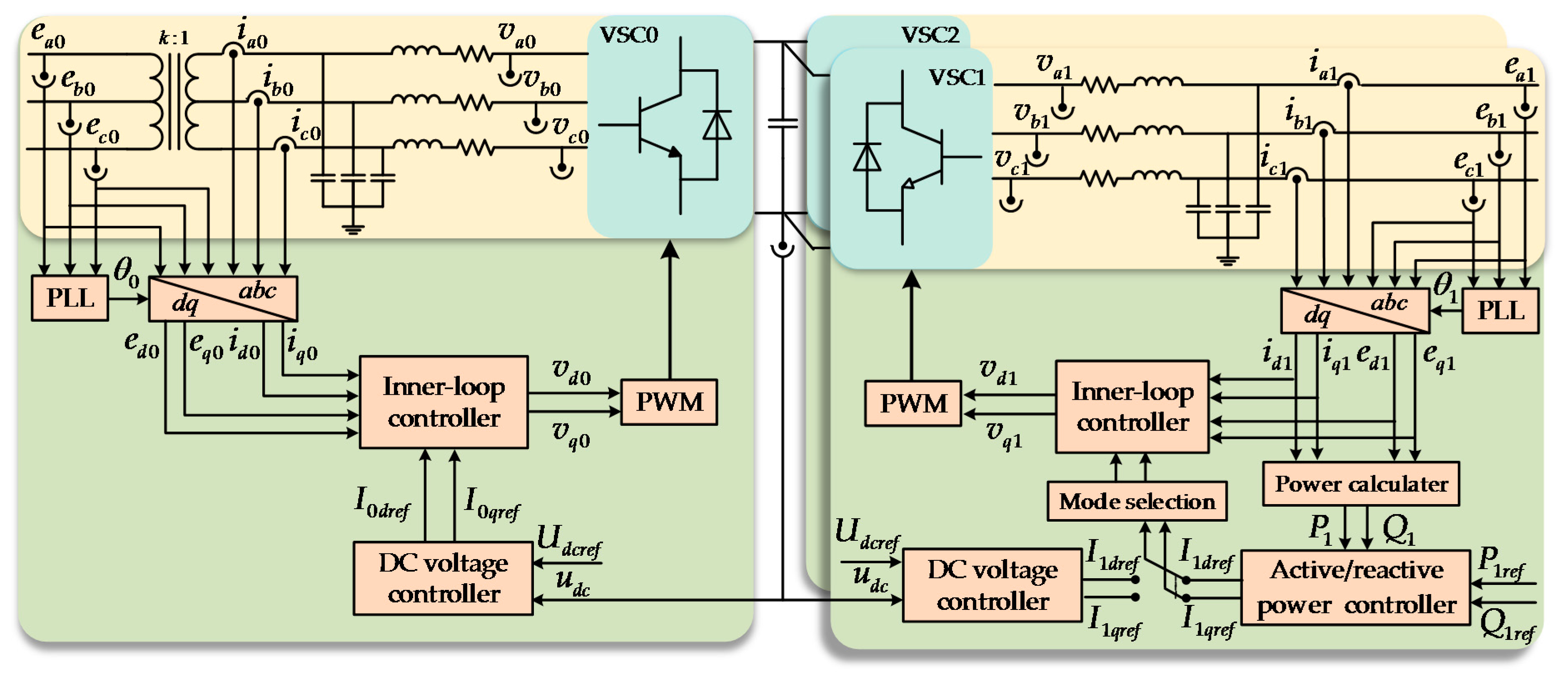
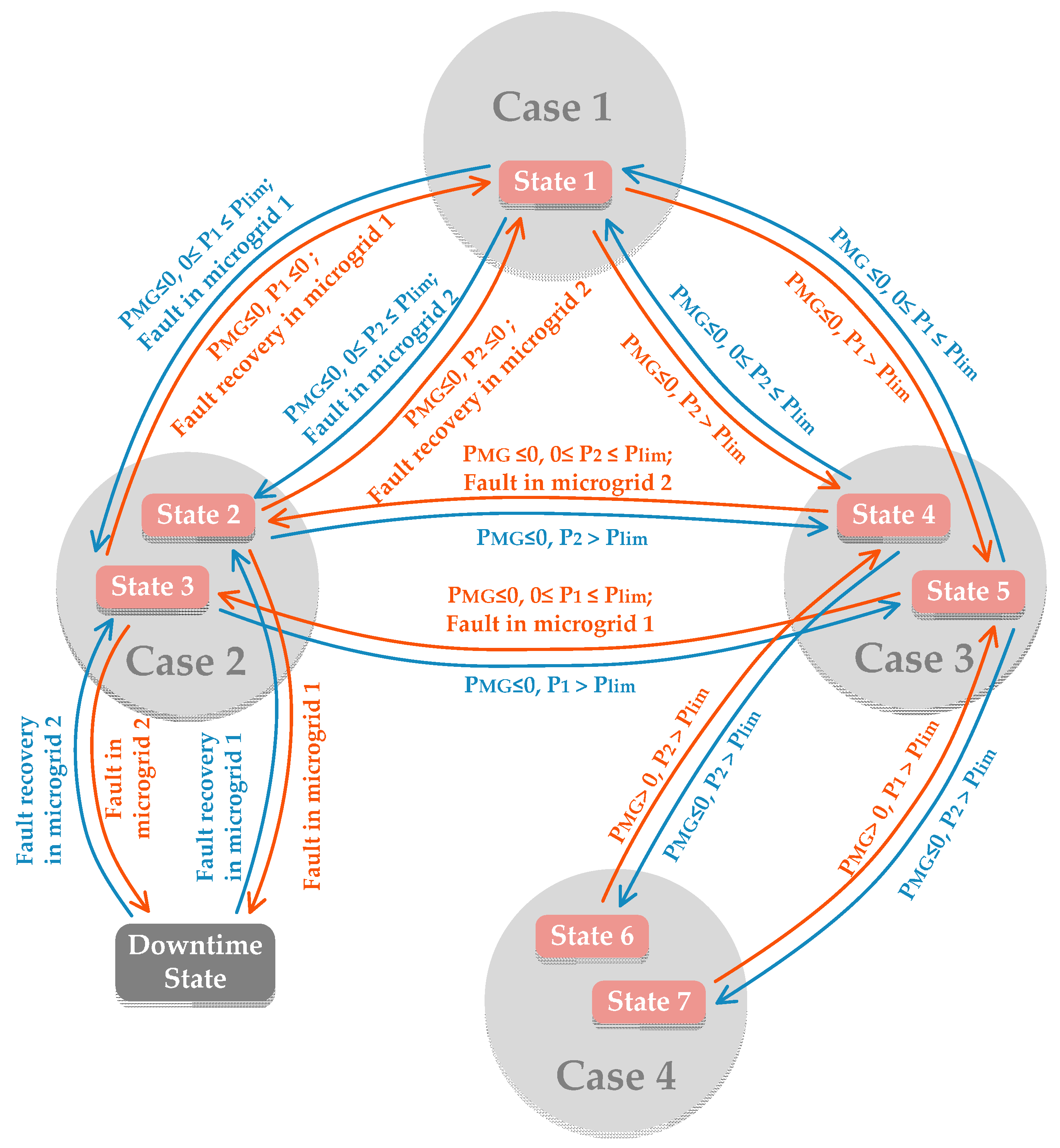

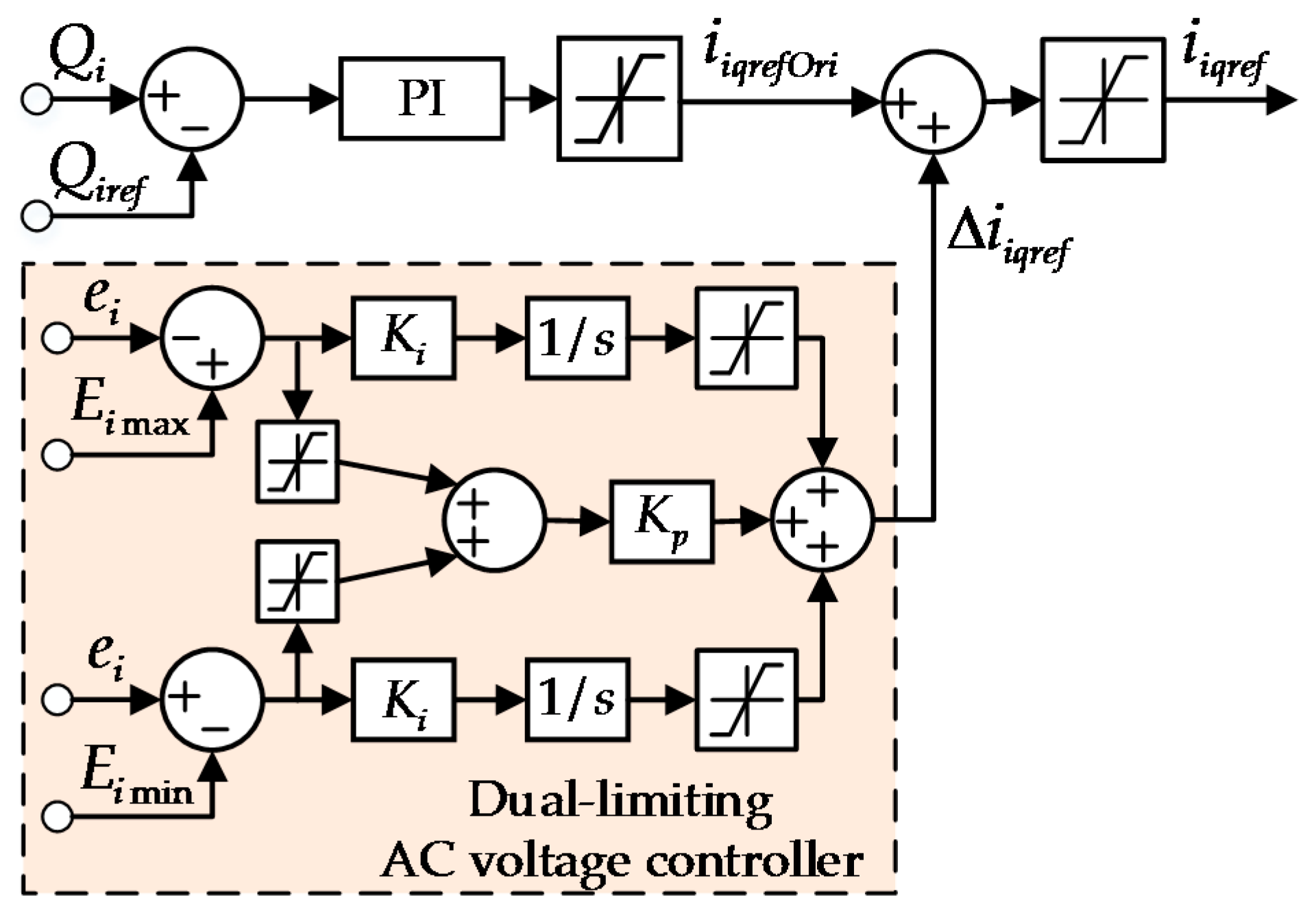


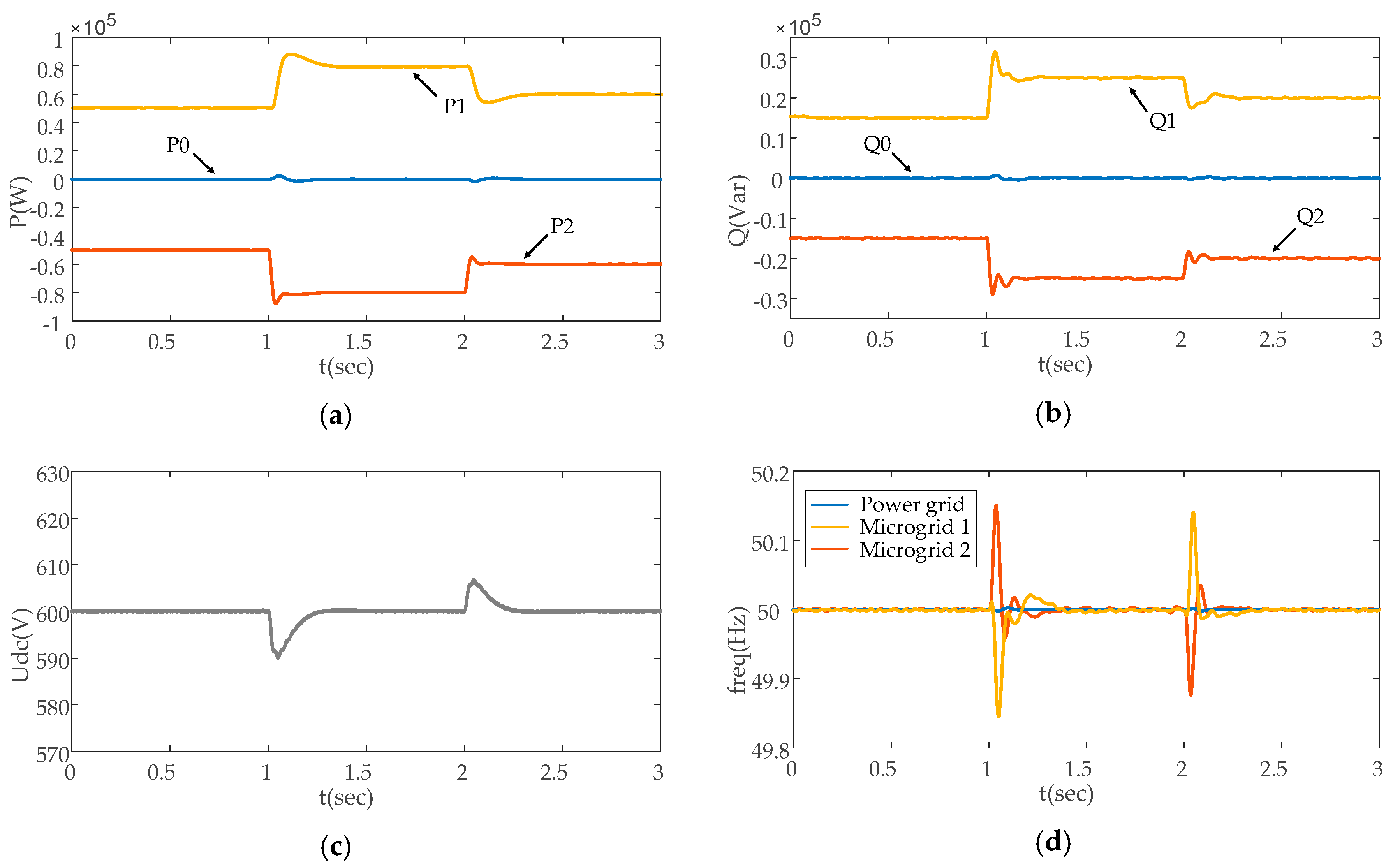

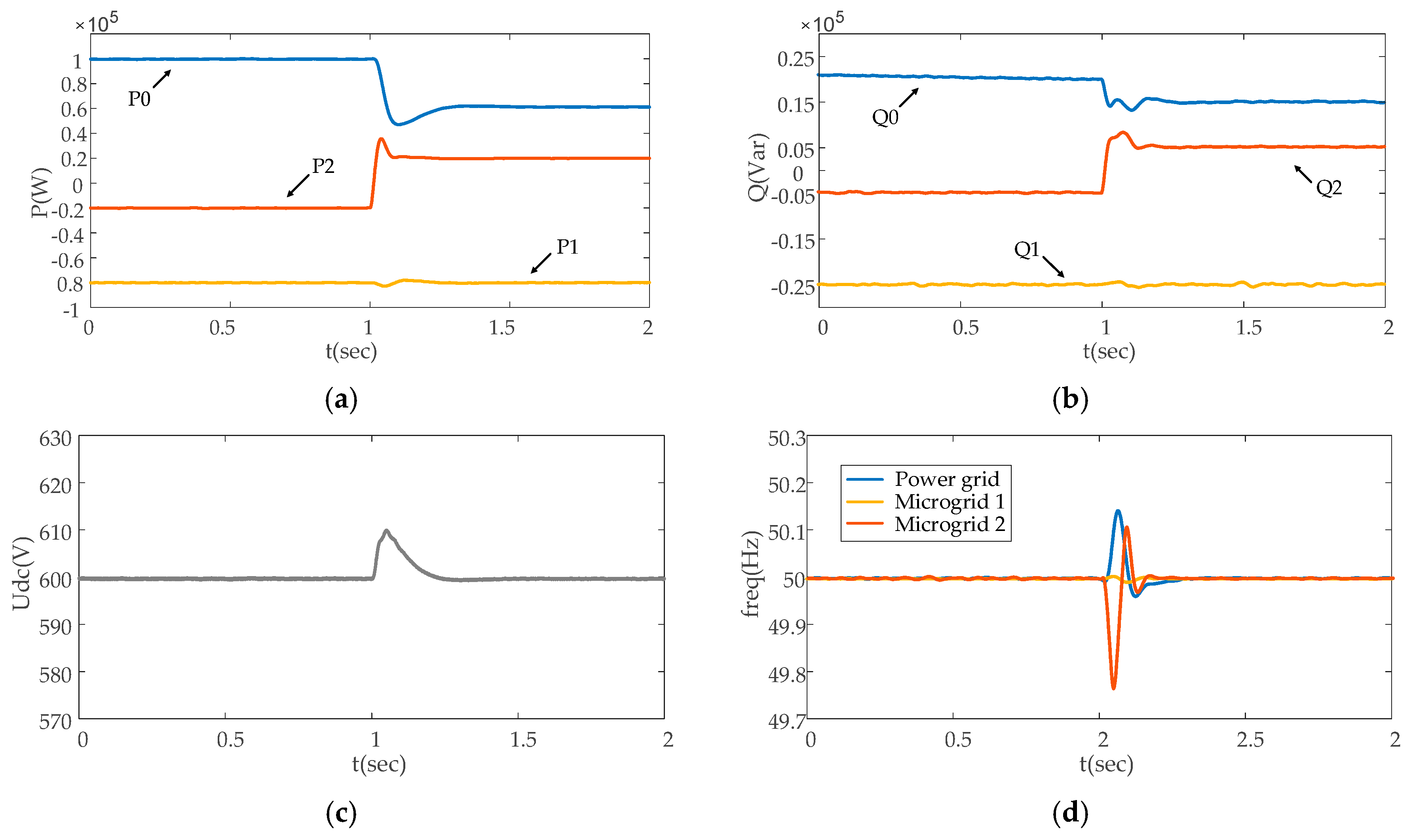
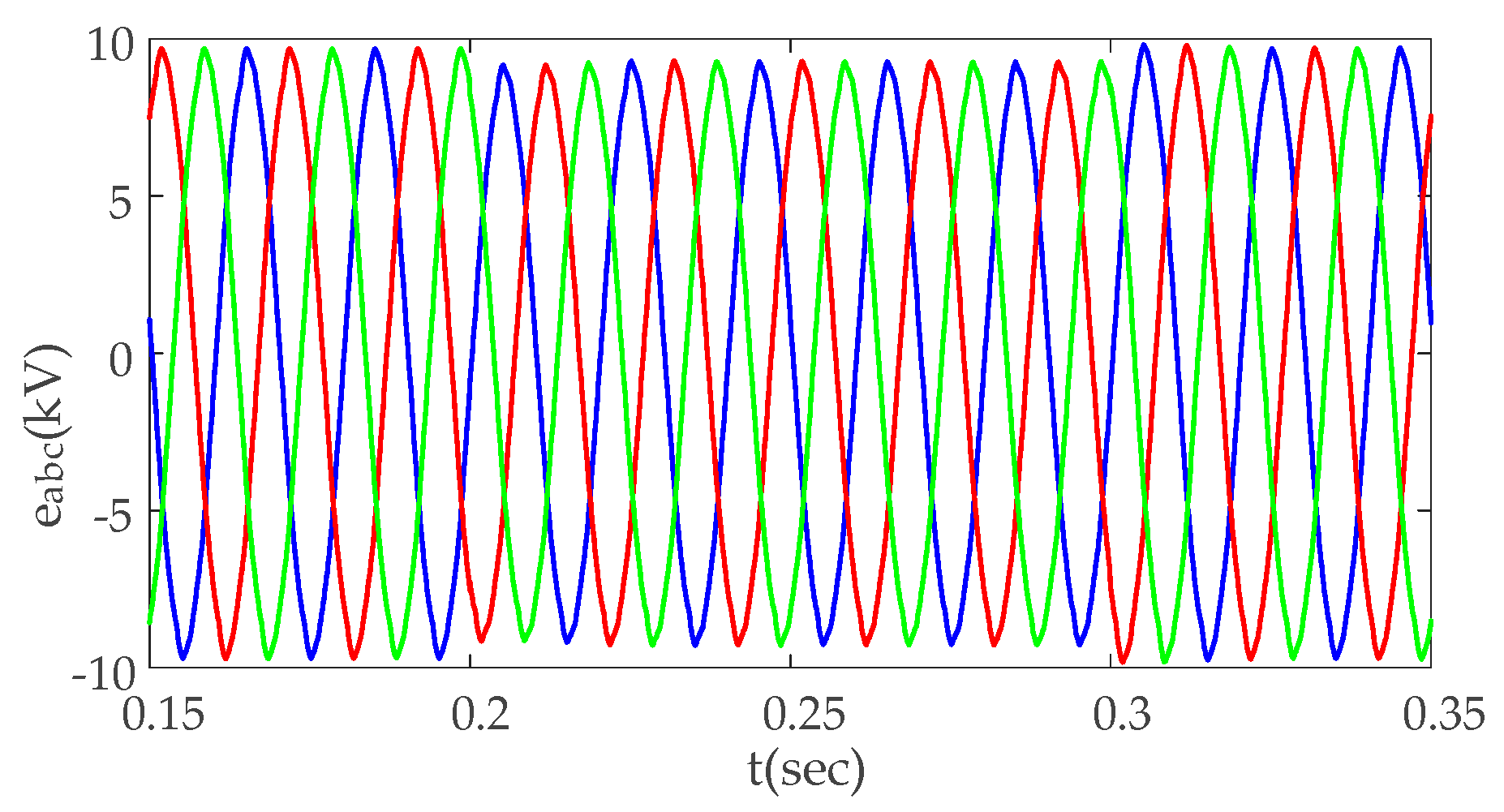
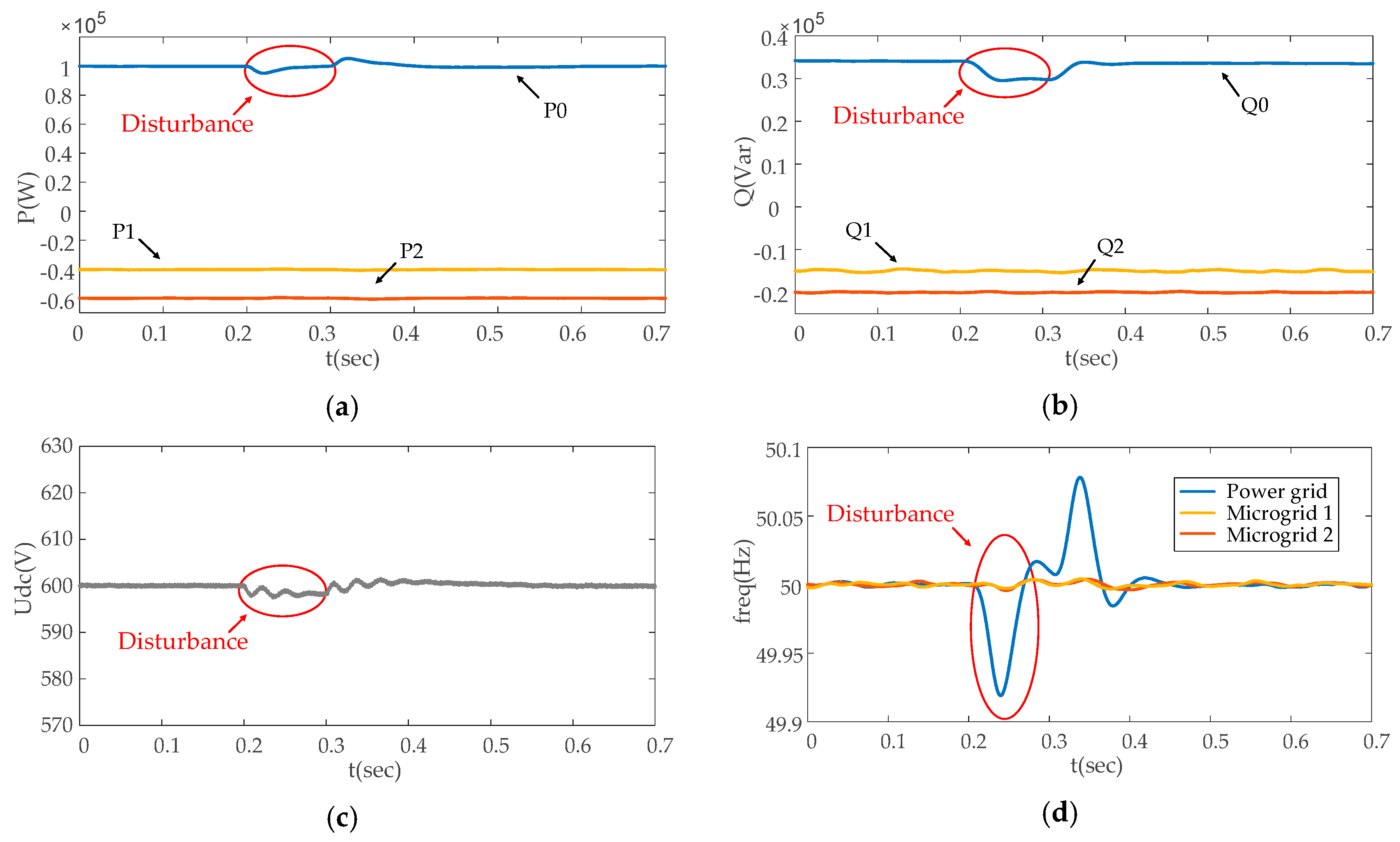
| Control Pattern | Inner-Loop Controller | Outer-Loop Controller |
|---|---|---|
| Pattern 1 (master control) | Rectifier | DC voltage loop control |
| Pattern 2 | Rectifier | Active/reactive power control |
| Pattern 3 | Inverter | Active/reactive power control |
| Operational Cases | Operational Mode of Microgrid 1 | Operational Mode of Microgrid 2 | VSC0 | VSC1 | VSC2 |
|---|---|---|---|---|---|
| Case 1 (Figure 3a) | Grid-connected mode | Grid-connected mode | Pattern 1 | Pattern 3 | Pattern 3 |
| Case 2 (Figure 3b) | Islanded mode | Grid-connected mode | Pattern 1 | None | Pattern 3 |
| Case 3 (Figure 3c) | Grid-connected mode | Parallel mode | Pattern 1 | Pattern 3 | Pattern 2 |
| Case 4 (Figure 3d) | Parallel mode | Parallel mode | None | Pattern 1 | Pattern 3 |
| State | Operation Case | Power Grid | Microgrid 1 | Microgrid 2 |
|---|---|---|---|---|
| 1 | Case 1 | Include | Grid-connected mode | Grid-connected mode |
| 2 | Case 2 | Grid-connected mode | Island mode | |
| 3 | Island mode | Grid-connected mode | ||
| 4 | Case 3 | Grid-connected mode | Parallel mode | |
| 5 | Parallel mode | Grid-connected mode | ||
| 6 | Case 4 | Exclude | Parallel mode | Parallel mode |
| 7 | Parallel mode | Parallel mode | ||
| 8 | Downtime | Island mode | Island mode |
| Parameters | Value |
|---|---|
| AC voltage of main grid | 10 kV |
| AC voltage of microgrid | 0.38 kV |
| DC-bus voltage | 600 V |
| DC-bus capacitance | 1 mF |
| Inductance of the filter | 0.25 mH |
| Capacitance of the filter | 250 μF |
| Switching frequency | 10 k Hz |
© 2017 by the authors. Licensee MDPI, Basel, Switzerland. This article is an open access article distributed under the terms and conditions of the Creative Commons Attribution (CC BY) license (http://creativecommons.org/licenses/by/4.0/).
Share and Cite
Liu, Y.; Fang, Y.; Li, J. Interconnecting Microgrids via the Energy Router with Smart Energy Management. Energies 2017, 10, 1297. https://doi.org/10.3390/en10091297
Liu Y, Fang Y, Li J. Interconnecting Microgrids via the Energy Router with Smart Energy Management. Energies. 2017; 10(9):1297. https://doi.org/10.3390/en10091297
Chicago/Turabian StyleLiu, Yingshu, Yue Fang, and Jun Li. 2017. "Interconnecting Microgrids via the Energy Router with Smart Energy Management" Energies 10, no. 9: 1297. https://doi.org/10.3390/en10091297




